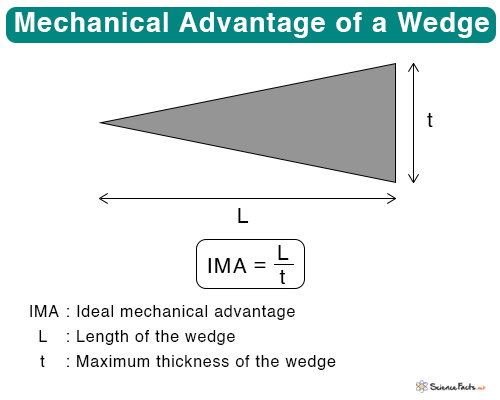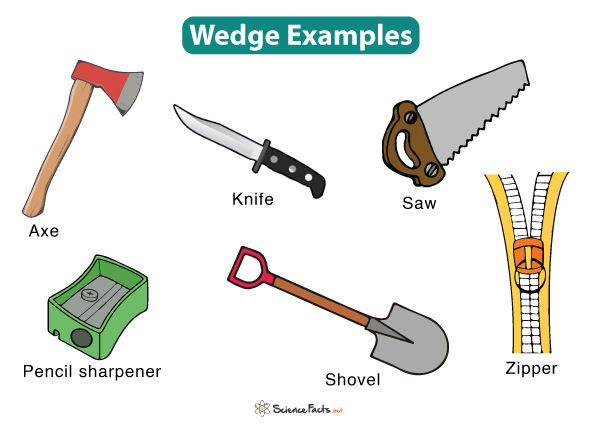Wedge
What is a Wedge
A wedge is a simple machine that has a triangular shape. It is thick at one end and tapers off to a sharp edge at the other. A wedge has one or two inclined planes. It is made out of wood, metal, plastic, or stone.
How Does a Wedge Work
A wedge has many functions like cutting, splitting, slicing, scraping, and holding. It works by changing the direction of the input force. Consider the image below, which shows a wedge with two inclined planes meeting at the sharp edge.
The sharp end of the wedge is placed on an object’s surface, and a force is applied on the blunt end. The force overcomes the object’s resistance and pushes the wedge into it. The wedge now applies a force inside the object at a 90˚ angle to its slope. This output force can split the object into two.
Mechanical Advantage of a Wedge
The mechanical advantage is its ability to multiply the applied force. This force is manifested at the interface between the wedge and object as the output force. The mechanical advantage analyzes the input and output forces and determines how much useful work the wedge can perform. There is an equation for the ideal mechanical advantage (IMA) of a wedge.
IMA = L/t
Where,
L: Length of the wedge
t: Thickness of the wedge at its thick end
The L/t ratio indicates the angle at the thin end of the wedge and hence the sharpness. Therefore, the force necessary to cut through the object depends on the wedge’s sharpness. A long and sharp wedge gives more mechanical advantage than a short and blunt one. Hence, it requires less force to cut through.
Types and Examples of Wedges
There are two different types of wedges – single wedge and double wedge. Many real-life examples of single and double wedges are found in homes.
1. Single Wedge: It has only one inclined plane.
Examples: Chisel, shovel, doorstopper, pencil sharpener, cheese grater, potato peeler, and needle
2. Double Wedge: It has two incline planes. They meet at the sharp edge.
Examples: Knife, saw, axe, and zipper
Other examples of wedges include a shim, staple, push pin, ice pick, tack, nail, and teeth.
Applications and Uses of Wedges
- Chopping wood using an axe, chain saw, or hand saw
- Stopping door from slamming using a doorstopper
- Making spears for hunting and tools for cutting and carving using stones by ancient human beings
- Grating cheese using a cheese grater
- Peeling potatoes and carrots using a peeler
- Sewing clothes using a needle
- Holding paper onto a board using a pushpin
Besides, jet planes, cruise ships, and modern cars use the concept of a wedge in their design. These transportations have a pointed nose and cut through air and water to overcome resistance.
-
References
Article was last reviewed on Tuesday, January 18, 2022











I am studying about simple machines and their examples. This website is really helpful to me. It gives a lot of examples of simple machines.
Thank you!